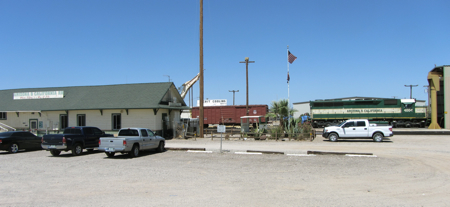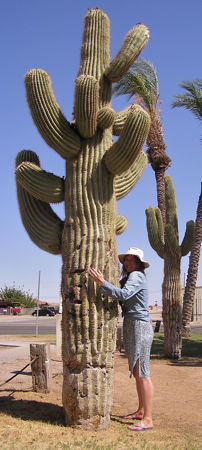We were walking down by the Comerica Theatre in Phoenix when we saw two middle-aged men, both white, riding bikes in circles on the sidewalk. One of them was riding a Dahon folding bike with 20 inch wheels. Carol has been looking at Dahons on Craigslist, so she asked the man how he liked the bike. The other man rode towards some people walking towards the theatre and asked if they wanted tickets, and then I noticed the man we were talking to had tickets in his hand. He knew a lot about bikes, and, like Carol, he regularly checks Craigslist for used bikes. The two of them compared notes on bikes they had seen for sale recently. He advised Carol not to get a Dahon, because they’re poorly made.
We got to talking about Phoenix, and the man on the bike said there just wasn’t much going on in downtown Phoenix. Restaurants, for example — he grew up in Portland, Oregon, where within a few blocks he had an unbelievable number of choices of restaurants, but in Phoenix there aren’t so many choices, and many of them are chain stores. I asked if there was any kind of bike culture, and he said there was not. not only that, but he said cars had no respect for bicyclists, and he had had more than a few close calls. What about jobs? we asked. His friend rode up at that point, and said most of the jobs in Phoenix were service jobs, paying seven-fifty or eleven dollars an hour.
Someone walked up looking for tickets, and the other man turned away to talk with them. The first man said he had come to Phoenix in the late 1990s, and he gave the impression that he wished he had never left Portland. One thing about Phoenix, he said, was that even though wages are low it was cheap to live here. But that meant it was hard to move anywhere else, hard to save up enough money to move away. You could feel stuck here, he said.
But he did like monsoon season. We asked what that was like. He said that it came in July and August, and you’d look up at the sky and see dark clouds moving in, and soon they’d cover the sky, and then there would be thunder and lightning everywhere, heavy rain, water running a half inch deep on the streets, then in thirty minutes it would all be over. He said it was worth seeing, and it was something he’d never seen in Portland.
Then some more people walked up looking for tickets, so we said good bye, nice talking to you, and went on our way.


